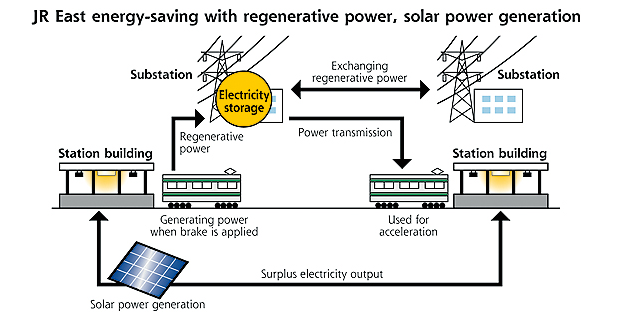Anyone who has ever seen the sparks fly and heard the gears grind as a train slows down and stops at a station knows the tremendous amount of power put in to apply the brakes. When a driver brings a train to a halt, electricity supply to the motors is cut.
However, the motors continue rotating with the wheels, producing what is called “regenerative power,” as it can be stored and fed back into the system, for use by nearby trains via power cables.
However, regenerative power can only be used when other trains are running on rails served by the same power substations; not on routes in remote areas, with fewer trains.
In May, Tokyo-based East Japan Railway Co. (JR East) – the largest passenger railway company in the world and one of the seven Japan Railways Group companies – started storing regenerative power to minimize consumption of conventional power in its mass transit operations.
Using the system, JR East plans to store regenerated power in batteries, and then use it to power accelerating trains running on sections covered by the same substations, or trains passing through the sections again.
The carrier has installed nickel hydride batteries in some power substations serving the Ome Line, in western Tokyo, on a trial basis. JR East expects the regenerative power storage on the Ome Line to cut electricity consumption by about 5 percent a year.
And later this year, JR East will install lithium-ion batteries with higher storage capacities in another power substation. Also, utilizing an ICT (information and communications technolog) system to analyze and adjust electricity flows, power substations that use alternating current (AC) will be able to efficiently transmit and receive regenerative power. JR East plans to develop the system and introduce it on parts of the Joban Line at the end of next fiscal year.
It expects the measure will reduce electricity consumption by 6 percent to 8 percent a year.

The Illustration above first appeared in the Daiy Yomiuri Online.
“Though railways are said to be environmentally friendly, we cannot rest on our laurels,” said JR East president, Tetsuro Tomita. “We'll introduce new measures as soon as possible and make great achievements for the future."
The system can also be used to manage solar power. JR East stations use electricity generated by solar panels for lighting and other purposes. But during peak hours on sunny days, some surplus power goes unused. On June 28, the company introduced the technology to store the electricity at Hiraizumi Station on the Tohoku Honsen Line.
At the station, all of the electricity needs at the station, including those at night, are covered by solar power generated on sunny days by combining solar power generation and storage batteries.
Other Japan-based railway companies also have started making efforts to minimize power consumption, by introducing new models of train coaches that consume less electricity, and exploiting alternative power technologies.
Starting as early as next year, Tokyo Monorail Haneda Airport Line, an elevated line that connects Haneda Airport in Ota, Tokyo, to Hamamatsucho Station in Minato, Tokyo, will introduce a system to store regenerative power to be supplied to other trains, using nickel-hydride batteries in two power substations.
Tokyu Corp., a major private railway operator in the Greater Tokyo Area of Japan, is studying the possibility of using the same technology.
Odakyu Electric Railway Co , Ltd. is a railway company based in Tokyo, best known for its Romancecar series of limited express trains from Tokyo to Odawara, Enoshima, Tama New Town and Hakone. The organization uses electricity generated by solar and wind power generators for lighting and other purposes in eight of its stations.
Keio Corp., a private railway operator in Tokyo, uses electricity from solar power generators for operations at its train depot.
Tokyo Metro Co. now uses LEDs in all front lights and inside train cars for its new 1000-type train introduced in April. The measure resulted in a 40- to 80-percent reduction in electricity consumption for lighting.
Want to learn more about the latest in communications and technology? Then be sure to attend ITEXPO West 2012, taking place Oct. 2-5, in Austin, TX. Stay in touch with everything happening at ITEXPO (News - Alert). Follow us on Twitter.
Edited by
Braden Becker